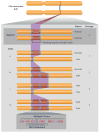Copy number variations in schizophrenia: critical review and new perspectives on concepts of genetics and disease
- PMID: 20439386
- PMCID: PMC3295834
- DOI: 10.1176/appi.ajp.2009.09071016
Copy number variations in schizophrenia: critical review and new perspectives on concepts of genetics and disease
Abstract
Objective: Structural variations of DNA, such as copy number variations (CNVs), are recognized to contribute both to normal genomic variability and to risk for human diseases. For example, schizophrenia has an established connection with 22q11.2 deletions. Recent genome-wide studies have provided initial evidence that CNVs at other loci may also be associated with schizophrenia. In this article, the authors provide a brief overview of CNVs, review recent findings related to schizophrenia, outline implications for clinical practice and diagnostic subtyping, and make recommendations for future reports on CNVs to improve interpretation of results.
Method: The review included genome-wide surveys of CNVs in schizophrenia that included one or more comparison groups, were published before 2009, and used newer methods. Six studies were identified.
Results: Despite some limitations, these initial genome-wide studies of CNVs provide replicated associations of schizophrenia with rare 1q21.1 and 15q13.3 deletions. Collectively, the results point to a more general mutational mechanism involving rare CNVs that elevate risk for schizophrenia, especially more developmental forms of the disease. Including 22q11.2 deletions, rare risk-associated CNVs appear to account for up to 2% of schizophrenia.
Conclusions: The more penetrant CNVs have direct implications for clinical practice and diagnostic subtyping. CNVs with lower penetrance promise to contribute to our genetic understanding of pathogenesis. The findings provide insight into a broader neuropsychiatric spectrum for schizophrenia than previously conceived and indicate new directions for genetic studies.
Conflict of interest statement
All authors report no financial relationships with commercial interests.
Figures


References
-
- Ali-Khan SE, Daar AS, Shuman C, Ray PN, Scherer SW. Whole genome scanning: resolving clinical diagnosis and management amidst complex data. Pediatr Res. 2009;66:357–363. - PubMed
-
- Stankiewicz P, Lupski JR. Genome architecture, rearrangements and genomic disorders. Trends Genet. 2002;18:74–82. - PubMed
-
- Redon R, Ishikawa S, Fitch KR, Feuk L, Perry GH, Andrews TD, Fiegler H, Shapero MH, Carson AR, Chen W, Cho EK, Dallaire S, Freeman JL, Gonzalez JR, Gratacos M, Huang J, Kalaitzopoulos D, Komura D, MacDonald JR, Marshall CR, Mei R, Montgomery L, Nishimura K, Okamura K, Shen F, Somerville MJ, Tchinda J, Valsesia A, Woodwark C, Yang F, Zhang J, Zerjal T, Armengol L, Conrad DF, Estivill X, Tyler-Smith C, Carter NP, Aburatani H, Lee C, Jones KW, Scherer SW, Hurles ME. Global variation in copy number in the human genome. Nature. 2006;444:444–454. - PMC - PubMed
-
- Iafrate AJ, Feuk L, Rivera MN, Listewnik ML, Donahoe PK, Qi Y, Scherer SW, Lee C. Detection of large-scale variation in the human genome. Nat Genet. 2004;36:941–951. - PubMed
Publication types
MeSH terms
Grants and funding
LinkOut - more resources
Full Text Sources
Medical

